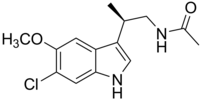TIK-301
 |
|
| Clinical data | |
|---|---|
| Routes of administration |
Oral |
| Legal status | |
| Legal status |
|
| Pharmacokinetic data | |
| Biological half-life | 1 hour |
| Identifiers | |
|
|
| CAS Number | |
| PubChem CID | |
| IUPHAR/BPS | |
| ChemSpider | |
| UNII | |
| Chemical and physical data | |
| Formula | C14H17ClN2O2 |
| Molar mass | 280.757 |
| 3D model (JSmol) | |
|
|
|
|
|
|
|
TIK-301 (LY-156735) is an agonist for the melatonin receptors MT1 and MT2 that is under development for the treatment of insomnia and other sleep disorders. Its agonist action on MT1 and MT2 receptors in the suprachiasmatic nucleus in the brain enables its action as a chronobiotic. It is in the same class of melatonin receptor agonists as ramelteon and tasimelteon.
TIK-301 was first developed at Eli Lilly and Co in Indianapolis, IN as LY-156735. In 2002, it was licensed by Phase 2 Discovery for further commercialization and worldwide development as PD-6735. In July 2007, the open Investigational New Drug (IND) was transferred to Tikvah Therapeutics Inc. in Atlanta, GA by Phase II Discovery, where it was renamed to TIK-301. Currently, clinical trials are ongoing there. Because it has been traded and sublicensed by multiple companies, it can referred to by all three names. Mostly recently and commonly, it is referred to as TIK-301.
TIK-301 was in phase II clinical trials in 2002. In 2004, TIK-301 was designated an orphan drug by the FDA. In 2005, TIK-301 was expected to go into phase III trials.
TIK-301 is a high affinity nonselective MT1/MT2 agonist. Studies show that it is more potent and more effective than melatonin. Its affinity for MT1 is similar to that of melatonin (pKi =10.38, Ki=81pM) and its affinity for MT2 is slightly higher (pKi=10.38, Ki= 42pM). This enantiomer had higher affinity for the binding site compared to the racemic mixture. The MT1/MT2 Ki ratio is 1.9. This slight preference for MT2 receptor is common among melatonin derivatives with chlorine. TIK-301's action on MT1 and MT2 receptors contributes to its sleep-promoting effects because melatonin's effects at these same receptors is linked with maintenance of normal-sleep wake cycle. TIK-301 was shown to be effective at promoting sleep at various doses; there is a positive dose response relationship between dose and reduction in sleep latency. The EC50 of TIK-301 is 0.0479nM, compared to 0.063nM for melatonin. It also acts as an antagonist at serotonin receptors 5-HT2B and 5-HT2C.
...
Wikipedia
